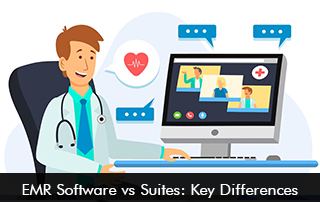EMR software has become an essential tool for modern healthcare providers, enabling efficient management of patient data. However, an Electronic Medical Records (EMR) alone is not enough to run a medical practice effectively. Providers also need Practice Management (PM) software to handle scheduling, billing, and administrative workflows, as well as Revenue Cycle Management (RCM) software to ensure smooth financial operations, including claims processing and reimbursement tracking.
Traditionally, many vendors have offered these systems as separate products, requiring healthcare organizations to purchase and integrate multiple solutions. However, a growing number of vendors now provide all three—EMR, PM, and RCM—as a single, unified suite. This raises an important question for healthcare providers: Should they opt for best-of-breed standalone systems from different vendors, or would an all-in-one suite be the better choice?
In this blog, we will examine the key differences between standalone EMR, PM, and RCM software versus integrated suites, explore the advantages and disadvantages of each approach, and help you determine which option best suits your practice’s needs.
Standalone EMR Software, PM Software, and RCM Software
Most healthcare software vendors initially developed specialized solutions focusing on one core function. EMR software was designed primarily for clinical documentation, allowing providers to store and access patient records digitally. These systems include features such as e-prescribing, lab integrations, and patient portals, making them indispensable for modern medical practices.
Separately, Practice Management (PM) software emerged to handle the administrative side of healthcare, including appointment scheduling, billing, insurance verification, and staff management. Meanwhile, Revenue Cycle Management (RCM) software became crucial for optimizing financial performance, with tools for claims submission, denial management, payment posting, and financial analytics.
While these standalone systems each serve a distinct purpose, relying on multiple vendors can create challenges. Data silos often develop when EMR, PM software, and RCM systems do not communicate seamlessly, leading to duplicate entries, billing errors, and inefficiencies. Additionally, managing separate software licenses, support contracts, and training programs can become costly and time-consuming. Staff may also struggle with switching between different platforms, slowing down workflows, and increasing frustration.
EMR Software All-in-One Healthcare Suites
Recognizing the limitations of disconnected systems, many vendors now offer comprehensive healthcare IT suites that combine EMR, PM, and RCM functionalities into a single platform. Leading examples include Epic, Cerner, NextGen Healthcare, and Athenahealth. These integrated solutions aim to streamline operations by ensuring that clinical, administrative, and financial data flow seamlessly across the entire practice.
One of the biggest advantages of an all-in-one suite is the elimination of data fragmentation. When patient records, appointment schedules, and billing information reside in a unified system, providers avoid manual data re-entry and reduce errors. This integration also enhances revenue cycle performance by automating claims submissions, reducing denials, and accelerating reimbursements.
Cost efficiency is another significant benefit. Instead of paying for multiple software subscriptions, training programs, and support services, practices deal with a single vendor, often resulting in lower long-term expenses. Additionally, compliance and reporting become simpler, as integrated systems ensure that data aligns with regulatory requirements such as MACRA and MIPS.
However, all-in-one suites are not without drawbacks. Some practices may find themselves locked into a vendor’s ecosystem, making it difficult to switch systems later if needed. The upfront costs of implementing a full suite can also be higher compared to adopting standalone solutions gradually. Furthermore, while suites offer broad functionality, they may lack the specialized features that some niche practices require.
EMR Software Standalone vs. Suite: Which Option is Right for Your Practice?
The decision between standalone systems and an integrated suite depends largely on the size, specialty, and operational needs of a healthcare organization.
For smaller practices or those with unique workflows, standalone EMR, PM, or RCM solutions may be preferable. If a clinic already uses a best-in-class PM system and is satisfied with its performance, integrating a new EMR might be more practical than overhauling the entire software stack. Standalone systems also allow for greater customization, enabling practices to select tools that precisely match their requirements.
On the other hand, larger practices, hospitals, and newly established clinics often benefit more from an all-in-one suite. The seamless coordination between clinical and financial operations reduces administrative burdens, minimizes errors, and improves overall efficiency. For organizations focused on scaling their operations, a unified system ensures that growth does not lead to software bottlenecks.
Key Factors to Consider Before Making a Decision
Before committing to either approach, healthcare providers should carefully evaluate several factors:
Integration Capabilities: If opting for standalone systems, ensure they can communicate effectively through APIs or interoperability standards like HL7 and FHIR. Poor integration can negate any benefits of using specialized software.
Total Cost of Ownership: Beyond initial licensing fees, consider expenses related to training, support, updates, and potential downtime during implementation. A suite may have a higher upfront cost but could prove more economical over time.
Scalability: Will the chosen solution accommodate future growth? Practices planning to expand services or locations should select software that can scale with them.
Vendor Reputation and Support: Reliable customer support is crucial, especially when dealing with mission-critical systems. Research vendor reviews and ask for references before making a decision.
Which Approach Wins?
For most healthcare providers, an all-in-one suite offers the best balance of efficiency, cost savings, and ease of use. The ability to manage clinical, administrative, and financial processes within a single system reduces complexity and enhances productivity. However, specialized practices or those with existing investments in standalone software may find that a best-of-breed approach better meets their needs.
Ultimately, the right choice depends on your practice’s unique requirements. By carefully assessing workflow demands, budget constraints, and long-term goals, healthcare organizations can select the solution that delivers the greatest value.







